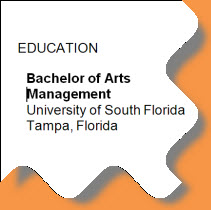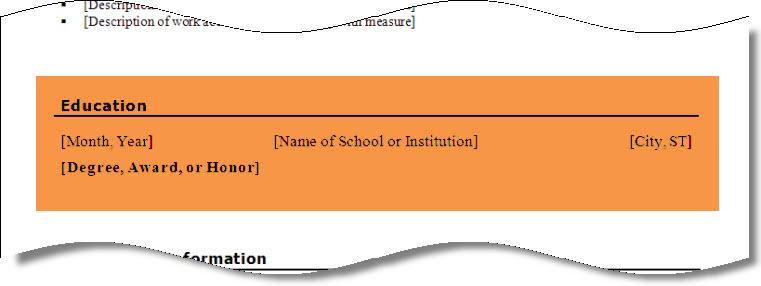
Resume Writing
Education Information
Introduction

After your work experience, the next most important factor that hiring managers look at on your resume is your educational background. Very often, there will be an education requirement for the job you want. To make sure a hiring manager knows that you meet this requirement, you should always include an education section on your resume.
In this lesson, you'll learn how to craft your educational background and what information you should include.
Education information
The education section tells an employer if you meet the educational requirements for a particular position. All resumes should include an education section, regardless of the level of education you have achieved.
To highlight your education, put this section directly below your career objective or summary of qualifications. To de-emphasize it, put this section last.
Click the buttons in the interactive below to learn more about the educational background section.
You try it!

Open your My Resume document to complete this activity. Enter your own information into this document as we progress through each part of the lesson. Begin by following the instructions below.
You will be working only in the Education portion of this document for this activity. Please refer to the following picture:

Replace the template text with your own information. Be sure to remove the brackets as you are replacing text.
- If desired, change the name of this section to reflect what you are including. Some suggested titles are:
- Educational Background
- Education and Training
- Education and Professional Development
- Replace the [Month, Year] with the name of the month and the year you completed (or expect to complete) your education.
- Enter the name of the school you attended in the [Name of School or Institution] placeholder. Use full names of the schools, such as Eastern College instead of the abbreviation EC.
- Include the city and state where you attended the program in place of the [City, ST] placeholder. Use state abbreviations.
- Enter the name of your degree or program in the [Degree, Award, or Honor] placeholder. This can include those earned at traditional two- and four-year universities, community colleges, educational institutions (such as GCFLearnFree.org) and vocational training, Armed Forces training, certifications, workshops, and high school diplomas or GEDs (if you are new to job market or don't have any additional training). For example, B.A., Communications, A.A., Marketing, or Certificate, Construction Management.
- If you are a recent graduate, you may want to include your GPA if it is noteworthy.
- If you are in the process of earning your degree, list it along with your anticipated date of completion.
- If you are including high school on your resume, you can simply use the word Graduated or include a specialty area or honors you received.
- Include any additional schooling or professional development you may have completed as well.
- Save and close the file. You will be adding to it as you progress through the lessons in this unit.
For workshops or training programs, include the workshop and provider name, location, and dates attended.